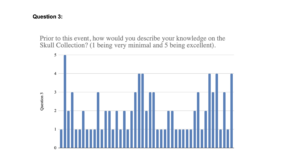1.5 Survey and Evaluations (Pt. 5)
From the onset of the project I was very passionate about creating a survey for our audience which we could then use to evaluate both the event itself as well as the knowledge gained from our project. It was clear that many members of the public, including university students and staff, were unaware of the existence of the Skull Collection, or even the Anatomical Museum. As a previous undergraduate of the university, I had only learned about both the collection and the museum through my MScR programme, and wanted to bridge this gap in knowledge for others.
After drafting and editing a survey, I created eleven questions for our audience members to respond to on the day of the event. Half of these would ask about their knowledge on a topic before attending, and then to review their knowledge afterwards. Additionally, there was a free response section which asked for suggestions on what should be done with the Skull Collection moving forward, as well as ways in which we could have improved the event.
The primary areas I was looking for increases in knowledge were surrounding the Skull Collection itself, decolonial museum practice and the illegal acquisition of human remains by the University. The data showed that for all three areas, audience understanding was relatively low prior to the event. Following the event, we see massive increases in knowledge on each topic area. In total we received 48 responses on our survey with the following result:

Sample survey graph which charts audience knowledge on the Skull Collection prior to the event.

Following the event, audience members on average showed great improvement in knowledge regarding the collection.
As a group, our targeted audience members were university staff and students. We wanted to ensure that the Anatomical Museum and the Skull Collection was made as widely accessible as possible across the university. Through online and in person promotion on campus, we successfully had 50 people attend our event, with students making up the largest demographic.

Sample graph which details the type of audience members in attendance.
Of those in attendance, the following disciplines made up the majority: History, Art History and Community Members. This was expected, and we were pleased to see a high turnout from local community groups who had a personal connection to the collection. The free response questions were as follows:
- How could this event have been improved?
- What should happen to the Skull Collection in the future?
For the first question the following answers were most commonly seen: changing or removing the creative workshop component (audience struggled to see the connection to the event), better audio in the lecture theatre and an extended period of time for the museum tour. Regarding the collection itself, a majority of the answers called for greater funding to the museum so that repatriation efforts could move forward. Overall, the survey data was extremely helpful in helping us understand the impact of the event and will be passed along to the curators of the Anatomical Museum moving forward.

